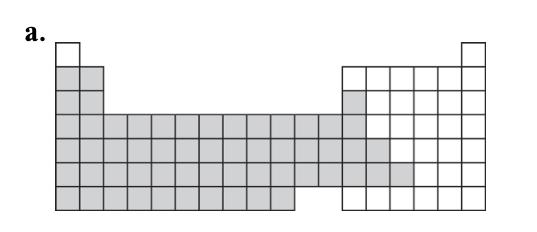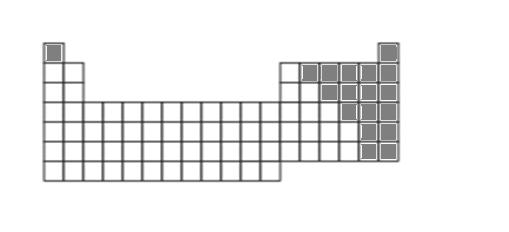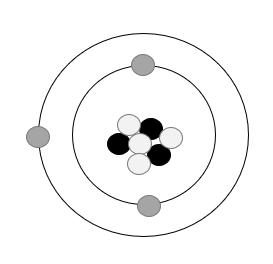

ANSWERS TO END-OF-CHAPTER QUESTIONS
CHAPTER 1: Portable Electronics: The Periodic Table in the Palm of Your Hand
Emphasizing Essentials
1. Answer:
a. Compound (2 molecules of one compound made up of two different elements).
b. Mixture (2 atoms of one element plus 2 atoms of another).
c. Mixture (3 different substances, two elements and one compound).
d. Element (4 atoms of the same element).
2. Answer:
a. element (4 molecules of one diatomic element)
b. Compound (2 molecules of one compound made up of two different elements).
c. Mixture (2 atoms of one element plus 2 atoms of another).
d. Compound (4 molecules of one compound made up of two different elements).
3. Answer: Exact answer will vary depending on viewing size of text. An approximate measurement for the period could be 0.25 mm. Converting this to nanometers: 0.25 mm ×
or
nm.
4. Answer:
Converting 10.0 nanometers to millimeters: 100nm × 1m 1×109 nm × 1000mm 1m = 1×10 5 mmor0.00001mm.
5. Answer:
a. 1.5 103 m
b. 9.58 10–11 m
c. 7.5 10–6 m
6. Answer: 1×102 cm, 1×106 μm, 1×109 nm
7. Answer:
a. Group 1 and Group 17
b. 1A: lithium, sodium, potassium, rubidium, cesium, francium 7A: fluorine, chlorine, bromine, iodine, astatine
c. 1A: All but hydrogen (a nonmetal) are reactive metals.
7A: All but astatine (a metalloid) are reactive nonmetals.
8. Answer:

b. iron, Fe; magnesium, Mg; aluminum, Al; sodium, Na; potassium, K; silver, Ag. c.

d. sulfur, S; oxygen, O, carbon, C, chlorine, Cl, fluorine, F (and others).
9. Answer:
a. compound b. compound c. mixture
d. element e. mixture f. element
10. Answer:
a. homogenous mixture if pulp-free b. heterogenous mixture c. heterogenous mixture
d. homogenous mixture e. heterogenous mixture
11. Answer:

Grey spheres: electrons
Black spheres: protons
White spheres: neutrons
12. Answer: There are several allotropes of sulfur. The most stable and common allotrope consists of 8 atoms in a ring. Other common allotropes include rings of 5, 6, 7, 10 and larger number of atoms. Most allotropes are yellow solids, although they can be found in liquid or gaseous forms at appropriate temperatures. Most of these allotropes are created by heating sulfur of the 8-membered ring form.
13. Answer:
An aluminum atom with mass number 27 has 13 protons, 14 neutrons, and 13 electrons.
14. Answer:
A copper atom with a mass number 64 has 29 protons, 35 neutrons, and 29 electrons.
15. Answer:
Electrical conductivity is the transport of electrons from one location to another. Thermal conductivity is the transfer of heat from one location to another Their difference is in what is being transferred.
16. Answer:
a. hafnium(IV) oxide
b. beryllium chloride
c. titanium(IV) hydroxide
d. iron(II) oxide
e. silicon dioxide
f. boron hydroxide
17. Answer:
a. 1 carbon atom (nonmetal), 2 oxygen atoms (nonmetals)
b. 2 hydrogen atoms (nonmetals), 1 sulfur atom (nonmetal)
c. 1 nitrogen atom (nonmetal), 2 oxygen atoms (nonmetals)
d. 1 silicon atom (metalloid), 2 oxygen atoms (nonmetals)
Concentrating on Concepts
18. Answer:
A variety of answers are possible. An example of an illustration of 9N purity is the time span of 1 second compared to 31.7 years. A similar example with 12 N purity is 1 second compared to 31,700 years. A volume-related example of 9N purity would be like taking 1 liter of water out of 400 Olympic-sized swimming pools full of water!
19. Answer:
Answers will vary widely but could include food, drink, furniture, books, and appliances, among others. Examples of homogeneous mixtures may be air (nitrogen, N2, oxygen, O2, argon, Ar, etc.), Gatorade (water, H2O, sucrose, C12H22O11, sodium chloride, NaCl, citric acid, C6H8O7, etc.), and glass (silicon dioxide, SiO2, sodium oxide, Na2O, calcium oxide, CaO, aluminum oxide, Al2O3, etc.). Examples of heterogeneous mixtures include books (cellulose, (C6H10O5)n, carbon black, C, titanium oxide, TiO2, polyvinyl acetate, (C4H6O2)n, etc.), granola bar (sucrose, C12H22O11, sodium chloride, NaCl, baking soda, NaHCO3, etc.), and a banana (water, H2O, glucose, C6H12O6, fructose, C6H12O6, isoamyl acetate, C7H14O2, etc.)
20. Answer: Answers will vary, depending on year selected. As of 2022, the smallest transistors used in electronic devices have features of 3 nm.
This is equivalent to 3 nm×
21. Answer:
-12 km.
The periodic table allowed gaps for unknown elements. The elements were placed into gaps based on their atomic weight and number of protons.
22. Answer:
There are many steps involved during this process. Many resources are available on the Internet that describe this process (e.g., http://www.australianminesatlas.gov.au/education/fact_sheets/aluminium.html)
23. Answer:
Sapphire is about three times as hard as Gorilla glass but is about 67% more dense. This means that although sapphire could greater resist scratches, a similar sized piece would weigh more than a piece of Gorilla glass. Gorilla glass has an amorphous structure composed primarily of silicon and oxygen atoms with other minority component atoms. Sapphire is a single crystal of aluminum and oxygen atoms. Both materials require high temperature melting of raw materials followed by slow cooling. Gorilla glass requires another heating step in a molten bath of salts. Sapphire requires a much higher temperature melt. Regular glass is also amorphous & is composed primarily of silicon and oxygen atoms with additives of sodium and calcium oxides. A comprehensive website that quantitatively compares the physical and optical properties of typical soda-lime glass, Gorilla glass, and quartz is found at: http://abrisatechnologies.com/specs/AT%20Specialty%20Glass%20Technical%20Capabilities%2 0Brochure.pdf
24. Answer:
A thin layer of a transparent conducting material is deposited on the surface of glass. The most common material used for this purpose is indium tin oxide (ITO), which is used in applications ranging from LED displays to solar cells. Do-it-yourself enthusiasts have posted to the internet a way to coat glass using stannous chloride (SnCl2) to create a layer of conductive tin oxide.
25. Answer:
When the surface of glass cools quickly in a Prince Rupert’s drop, silicon and oxygen atoms form tight bonds that hold the material into shape. The silicon and oxygen atoms within the drop are still semi-mobile while the outer surface is hardening. When the interior of the drop cools, new bonds between silicon and oxygen form, pulling them tighter together. However, since the other layer of glass is held tightly in place, the atoms on the interior are not able to approach each other as close as optimal, resulting in internal stress. When some of the bonds between silicon and oxygen atoms in the surface of the glass are broken, the internal bonds are pulled tightly together with enough strength to further break additional bonds in the outer layer. This results in the shattering of the drop as bonds throughout the glass break or shrink.
26. Answer:
Answers will vary depending on device and component choice, but typical components and sizes include length (e.g. 14.5 cm, 145 mm, 145,000 µm, 145,000,000 nm); width (e.g. 7.5 cm, 75 mm, 75,000 µm, 75,000,000 nm); thickness (e.g. 1 cm, 10 mm, 10,000 µm, 10,000,000 nm); camera lens (e.g. 0.3 cm, 3 mm, 3,000 µm, 3,000,000 nm); and speaker hole diameter (e.g. 0.03 cm, 0.3 mm, 300 µm, 300,000 nm).
27. Answer:
The list of metals used in cell phones that are common in Earth’s crust includes: aluminum, iron, potassium, magnesium, titanium, manganese, barium, and nickel. They are found in ores, minerals, and compounds.
28. Answer:
A transparent material allows light to travel through it without refracting. Having a transparent screen keeps the light produced from distorting when you look at it. Additives can give solids like glass a different color or other properties like strength. Heat treatment can also add durability.
29. Answer:
Gold prospectors can use panning to separate gold flakes from other solids. This involves taking the mixture and agitating it in water. This separates out the gold because it stays in the bottom of the pan and other substances float in the water and can be poured out.
30. Answer:
The steps involved to convert silica sand, mostly composed of SiO2, to high-purity Si are outlined in Section 1.8. In contrast, sea sand contains many impurities such as metals (e.g., Fe, Al, Mg, K, Na, Ca, Zn, Ni, etc.) and nonmetals (e.g., B, P) that would require extensive pre-processing of the sand via chemical reactions, involving acids and high temperatures. Furthermore, the use of sea sand for industrial processes would not be sustainable and would cause a variety of environmental consequences. By disturbing sea sand, an area could be changed physically, biologically, and chemically.
31. Answer:
Waste products of high-purity silicon include carbon monoxide (from reduction of the silicon), carbon dioxide (from combustion heating), compounds containing the impurities (including phosphorous, boron, and a variety of metals), and waste heat.
32. Answer:
While individual cell phones may become smaller and take up less space in, say, a landfill, there may be a much higher impact on the environment, depending on the materials required for making the cell phone and the energy needed for manufacturing the components. To make the devices smaller and less expensive, different materials may be used, which may require more invasive mining or greater waste production in the manufacturing process.
33. Answer:
Answers will vary according to relative weighing of factors. The grade for the “Environmental” pillar should consider the production and recycling of waste and the relative use of limited natural resources, including rare earth metals. The grade for the “Social” pillar should include both the impact of portable electronics on the quality of life of consumers as well as the impact on the lives of workers in the mining of raw materials, manufacturing of the products, and those that live in the regions impacted by mining and manufacturing. The grade for “Economic” pillar should consider the wealth generated by the mining, manufacturing, and sale of these electronics and how this wealth is distributed.
Exploring Extensions
34. Answer:
Gordon Moore, one of the founders of the computer chip maker Intel, predicted in 1965 that the number of transistors per square inch on integrated circuits would double every 12 months. In 1975, he revised his prediction to double every 24 months. This prediction has held true through
at least 2016. However, both Moore and current Intel CEO Brian Krzanich have recently suggested that chip makers may reach physical and economic limitations to this growth within the next 5-10 years.
35. Answer:
The colors of many gemstones come from impurities in the crystal structure. For example, the purple color of amethyst comes from Fe3+ ions in a SiO2 crystal, and the red color of rubies comes from Cr3+ in an Al2O3 crystal.
36. Answer:
Impurities break up the crystal structure of crystalline solids and, since properties of materials are in part dependent on structure, this will change the material properties. Throughout this chapter, we have seen impurities that change properties such as color, transparency, melting point, and electrical conductivity.
37 Answer: A thin layer of material is sandwiched between two pieces of glass. When an electrical current is passed through the glass, the material will line up according to the direction of the current, similar the liquid crystal display (LCD) of common calculators.
38. Answer:
Devices can be physically pulled apart to reveal the components containing the metals. Plastic parts such as circuit boards are either dissolved in solvent or burned to isolate the metallic components. These metals themselves may be either melted or dissolved in acids and then filtered and reconstituted to generate purer forms of the metal for other uses. A recent report describes the use of fungi to extract precious metals from electronic waste, a potentially more environmentally friendly way of recycling.
39. Answer: Apple has removed mercury and arsenic from screens and lead from solder in their electronics.
40. Answer:
The two largest destinations for electronic waste in the world are in New Dehli, India, and Guiyu, China. Studies have shown air, water, and soil pollution from electronics recycling around Guiyu leading to poisoning from heavy metals such as lead and organic pollutants such as dioxins. To prevent these situations, new methods of recycling need to be developed with greater safety awareness for workers, tighter controls on emissions from recycling centers, and redesign of the electronic devices to reduce toxic components.
41. Answer: Old electronic devices could be disassembled and either parts could be reused as is or could be mechanically or chemically separated into raw materials to be used for manufacturing new devices.
42. Answer:

The H2 and SiCl4 gases are recycled through reaction to generate chlorosilanes that are used to purify the Si in earlier steps. However, CO is released, which is further oxidized to CO2, a greenhouse gas.
43. Answer:
Answers will vary as there are many ways to strengthen glass. This may include heating the glass or adding different elements into the structure.
44. Answer:
In 2021, there were 240 million iPhones sold worldwide. Although estimates vary, if we assume that each iPhone contains 0.034 g of Au, 0.34 g of Ag, 0.015 g of Pd, 25 g of Al, and 15 g of Cu, that would correspond to 8.2 million grams of Au, 82 million grams of Ag, 3.6 million grams of Pd, 6 billion grams of Al, and 3.6 billion grams of Cu! If 25% of iPhones are recycled, the amount of metals recovered would be 0.25 times the above values. To calculate the value of these metals, you would look up the current cost of metals and multiply by the amount of metals recovered. For instance, as of 11/23/22, the current price of gold was $56.38/g, which would equal: (8,200,000 g) × 0.25 × $56.38 = $115,579,000 per year for gold alone! Remember that this is only from iPhones; other major brands such as Samsung, Huawei, etc. also contain precious metals.
45. Answer: refer back to Figure 1.24. A cradle-to-cradle scenario would include recycling of metals, plastics, etc. in the phone back into a useful end product.
46. Answer:
One consideration includes the use of fossil fuels to power computers and equipment used for synthesis and testing of materials, as well as extensive travel by marketing personnel. Another consideration includes the disposal of waste generated during fabrication and testing of new materials.
47. Answer:
To extract aluminum from ore, bauxite is crushed and dissolved in a solution of concentrated sodium hydroxide to remove aluminum oxide from the rest of the ore. The aluminum oxide-
sodium hydroxide mixture is then neutralized and is mixed with sodium aluminum fluoride (cryolite). At high temperatures, a carbon electrode is used to reduce the aluminum oxide to molten aluminum. This process is very energy intensive and expensive. Aluminum recycling involves collecting used aluminum, cleaning the metal, then melting the metal to remove any coating, and then cooling the metal to form solid aluminum. The recycling process uses high temperatures to melt the metal, but uses much less energy and is more cost efficient than extraction. Recycling uses more than 90 percent less energy than extraction from bauxite.
48. Answer:
The increase in demand for rare earth metals amounts to about 40%. Rare earth metals are used in a wide variety of products such as cell phones, computers, rechargeable batteries, wind turbines, speakers, and fluorescent lights. It is doubtful that the U.S. could meet its demand for rare earth elements even with 100% recovery of the metals. The growth of the market for this wide variety of products outpaces the retirement of old products, many of which may not use much, if any, rare earth metals that could be recycled.
